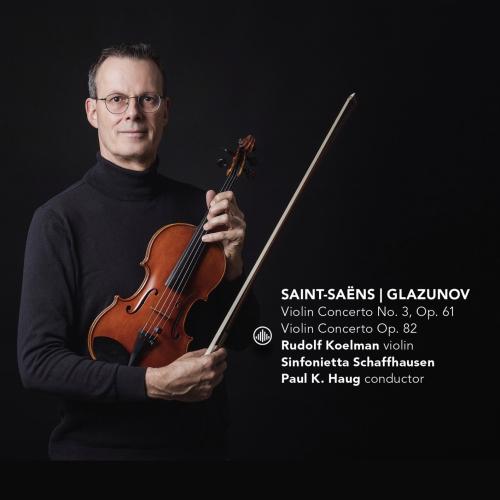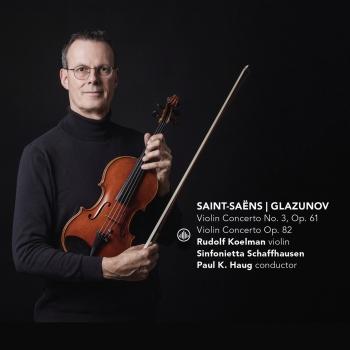
Violin Concertos Rudolf Koelman, Sinfonietta Schaffhausen & Paul K. Haug
Album info
Album-Release:
2023
HRA-Release:
07.07.2023
Label: Challenge Classics
Genre: Classical
Subgenre: Concertos
Artist: Rudolf Koelman, Sinfonietta Schaffhausen & Paul K. Haug
Composer: Camille Saint-Saens (1835-1921), Alexander Glasunow (1865-1936)
Album including Album cover Booklet (PDF)
- Camille Saint-Saëns (1835 - 1921): Violin Concerto No. 3 in B Minor, Op. 61:
- 1 Saint-Saëns: Violin Concerto No. 3 in B Minor, Op. 61: I. Allegro non troppo 08:32
- 2 Saint-Saëns: Violin Concerto No. 3 in B Minor, Op. 61: II. Andantino quasi Allegretto 07:34
- 3 Saint-Saëns: Violin Concerto No. 3 in B Minor, Op. 61: III. Molto moderato e maestoso - Allegro non troppo 11:00
- Alexandr Glazunov (1865 - 1936): Violin Concerto in A Minor, Op. 82:
- 4 Glazunov: Violin Concerto in A Minor, Op. 82: I. Moderato 03:51
- 5 Glazunov: Violin Concerto in A Minor, Op. 82: II. Andante 06:51
- 6 Glazunov: Violin Concerto in A Minor, Op. 82: III. Cadenza 02:02
- 7 Glazunov: Violin Concerto in A Minor, Op. 82: IV. Animando - Allegro 05:58
Info for Violin Concertos
These two splendid violin concertos breathe the air of Late Romanticism. Well orchestrated and skilfully written for the soloist, they have retained their footholds in the repertoire, even though their respective composers have gone out of fashion. Camille Saint-Saëns’ Third Violin Concerto in B minor had the absolute certainty and conviction of a masterpiece. Saint-Saëns wrote it early in 1880 for the popular Spanish virtuoso Pablo de Sarasate.
Although Alexander Glazunov (1865-1936) was a pupil and lifelong friend of Nikolai Rimsky-Korsakov, he can be seen as heir to Tchaikovsky’s Romantic, heart-on-sleeve approach to composition.
The A minor Violin Concerto of 1904 is perhaps Glazunov’s most striking work, in fact the sole criticism one might make is that it takes only 20 minutes to play, which means it fits awkwardly into today’s stereotyped classical concert programmes. Like the Saint-Saëns B minor, it was written for a great fiddler, in this case the Hungarian Leopold Auer who was the leading player on the Russian scene.
Rudolf Koelman’s teacher Jascha Heifetz learnt the Concerto directly from Auer. At the St Petersburg Conservatory on 18 January 1914 Heifetz and Glazunov got together to present the Concerto; and the story goes that the almost-13-year-old’s fee was a bicycle.
Heifetz told Rudolf Koelman that he would have liked to record the Saint-Saëns B minor as well, but somehow it did not happen.
Rudolf Koelman, violin
Sinfonietta Schaffhausen
Paul K. Haug, conductor
Rudolf Koelman
The Dutch violinist Rudolf Koelman performs regularly as a soloist with numerous internationally renowned orchestras such as the KBS Symphony Orchestra, the Tokyo Philharmonic, the Royal Concertgebouw Orchestra, the Amsterdam Sinfonietta, the WDR Radio Orchestra, the Queensland Symphony Orchestra and many others.
He was one of the last students of Jascha Heifetz (LA, 1978 to 1981) and first conductor of the Royal Concertgebouw Orchestra (until 1999). Rudolf Koelman teaches at the Zurich University of the Arts (ZHdK) and is often invited as a juror and guest professor to international violin competitions and master classes around the world.
Rudolf Koelman has made numerous TV, radio and CD recordings, including a live recording of all 24 Paganini Capricci. In 2010 he performed at the Concertgebouw Amsterdam and recorded both Paganini Violin Concertos 1 & 2 live (CC 72343 Challenge Classics). These recordings were released on Challenge Records and won the prestigious Edison Award 2010 in the Netherlands.
Rudolf Koelman plays the Stradivarius "Ex Woolhouse" 1720.
Paul K Haug
has been the artistic director and conductor of the Sinfonietta Schaffhausen since 2004 and has had a decisive influence on the successful development of the orchestra.
Paul K. Haug grew up in Thalwil near Zurich. He completed his music studies at the Winterthur Conservatory (piano) and discovered his talent and joy in conducting while conducting a church choir. After graduating in Winterthur, he therefore studied choir and orchestra conducting at the Trossingen University of Music. He attended master classes with Warren Thew (piano) and John Eliot Gardiner (conducting).
After graduating, he worked at the Zurich Drama Academy, today's Zurich University of the Arts ZHdK, as a theater musician and répétiteur. What the weekly newspaper Die Zeit writes in its issue no. 03 / 2009 applies to Paul K. Haug in a special way: “Actor répétiteurs must have 15 fingers and the hands of a Goliath”; Accompanists are great musicians and all-rounders at the same time. The sentence is tailored to Paul K. Haug: for ten years he directed the MKS, music school and conservatory in Schaffhausen, wrote music for ballet, theater and schools. For one season he was Kapellmeister at the Circus Krone in Munich. He works successfully as an orchestra conductor, music teacher, pianist, choir director, répétiteur, composer and arranger. He wrote almost all the arrangements on the Sinfonietta Schaffhausen's latest CD, Wild Strawberries. For the ballet La dolce vita, which premiered in February 2013 together with the Junior Dance Company and the Sinfonietta Schaffhausen, he wrote the lively final act of the evening, according to the wishes of the choreographer and with motifs from Nino Rota's film music.
A second focus of Paul K. Haug's career, alongside conducting, is theater work. Together with theater professionals, he has been enriching cultural life in Schaffhausen for several years with very popular scenic and musical productions, which both experienced concertgoers and younger listeners and the whole family enjoy: The Little Niederdorf Opera was created in collaboration with the director René Egli, and with the Kleine Bühne Schaffhausen he realized the plays Rasmus and the Tramp, The Gingerbread Man, The Threepenny Opera, Ronja the Robber's Daughter, Cinderella and in December 2017 The Magic Organ. The arrangements for the New Year's Eve concerts, which are usually sold out well in advance, were also penned by the versatile conductor of the Sinfonietta Schaffhausen.
Sinfonietta Schaffhausen
Depending on the programme, around 50 professional musicians play in the Sinfonietta Schaffhausen, which was founded in 2004. (Strings, woodwinds, brass and percussion.) Paul K. Haug, the conductor: “We started out as a string ensemble, playing on modern instruments. This means that we make very little baroque music, because nowadays this music is mainly played on 'original instruments'. That's how we worked our way into the Viennese classic and the longer we added the more wind instruments. Meanwhile, we've moved on to romance and are now conquering the rest of the repertoire attainable for our size.”
Hallmarks of the Sinfonietta Schaffhausen are, among other things, contrasting programs with mutual references between the well-known and the lesser-known. This can be a concert on the theme of composers from French-speaking Switzerland (Romandie), where, for a surprising and good reason, Fryderyk Chopin also makes an appearance; or an evening in G minor, with works by Joseph Haydn, Francis Poulenc and Wolfgang Amadeus Mozart. The Sinfonietta is dedicated to Scha with the same enthusiasm ...
Booklet for Violin Concertos











